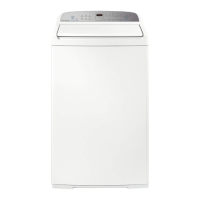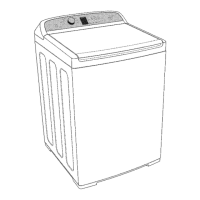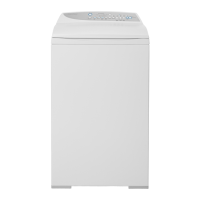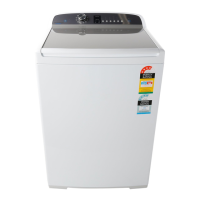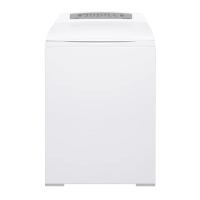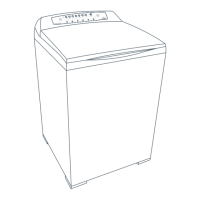
Do you have a question about the Fisher & Paykel FabricSmart and is the answer not in the manual?
| Brand | Fisher & Paykel |
|---|---|
| Model | FabricSmart |
| Category | Washer |
| Language | English |
Microprocessors control every aspect of the washer for optimal performance.
Washer uses minimal electricity, equivalent to a 100-watt bulb for an hour.
Revolutionary motor offers infinite wash actions and fabric care.
Fewer moving parts mean greater reliability for the FabricSmart™ washer.
Combines front and top loader tech for better soil removal and energy saving.
Flexible fins sense fabric resistance for optimal wash action.
Uses up to 25% less water than traditional rinse without compromising performance.
Steps to remove packaging and prepare the washer for use.
Detailed steps for removing outer packaging and internal protective materials.
Requirements for installing the washer on a level surface.
Instructions for connecting and positioning the drain hose correctly.
Connecting the hot and cold water inlet hoses correctly to the machine.
Steps to ensure the machine is level for optimal spin performance.
Recommended hot water temperature and water pressure requirements.
Ensuring the drain path is clear and complying with local by-laws.
Important safety information regarding supervision of children.
Warning about using extension cords or portable outlets with water.
List of available spare parts and their part numbers.
A checklist to ensure correct installation and setup before the first wash.
Details the load capacity (dry weight) for different machine sizes.
Instructions on how to add detergent to the agitator.
How to use the power, options, and start/pause buttons.
Symbols displayed on the screen to show cycle progression.
Introduces Fabric Care and Lifestyles cycles for easier washing.
Adjusting the soil level for different load conditions.
Special wash action with soaks to remove stains.
How the machine displays cycle stage and remaining time.
Combines front and top loader tech for better soil removal and energy saving.
First phase saturates clothes with detergent solution for effective cleaning.
Second phase uses cool water and agitation to remove soil from fibres.
The lid locks during spinning for safety, indicated by a symbol.
Chart showing when the lid is locked or unlocked during different cycle stages.
Precautions regarding lid operation, opening, and child safety.
Differences in hot water usage for Eco Active™ and Traditional washes.
Table showing total water usage for various wash programs and water levels.
Introduces OPTIONS, LIFESTYLES, WASH ADVANCE, and TEMPERATURE menus.
Steps to access and choose settings from the OPTIONS menu.
How to program preferred wash settings for future use.
Options for selecting wash temperatures from Cold to Hot.
Automatic water level sensing and manual selection for loads.
Advance the cycle or start at a specific stage, like prewash.
Options to limit the spin speed to fast or medium.
Adjust soil level if not set initially or changed mind.
Set a delay for the wash cycle start from 15 minutes to 18 hours.
Pause after rinse to remove drip-dry items before final spin.
Adds a soak period to the wash cycle for better stain removal.
Shortens cycles for lightly soiled clothes by reducing rinse/spin times.
Traditional SAVE WATER and ECO (SAVE WATER++) options for water saving.
Describes the conventional top-loading wash method.
Information on fine-tuning wash options and display settings.
Steps to enter the SETTINGS menu for adjustments.
How to adjust wash temperatures in degrees Celsius.
How to increase or decrease the auto fill water level.
Changing the automatic rinse type (e.g., Single Deep, Shower).
Adjusting spin speed for the Easy Iron cycle.
Options for automatic correction or machine stop on imbalance.
Setting the number of beeps signalling the end of a cycle.
Restoring all settings to factory defaults.
Adjusting screen brightness and contrast.
How to access and choose from Lifestyles menus like Family, Sports, Stains.
Overview of traditional wash cycles like Auto Sensing, Easy Iron, Wool, Handwash.
Saving and using your preferred wash settings as a custom cycle.
Specific cycles for Nappy Rinse, Duvet/Doona, and Allergy needs.
Cycles designed for athletic wear, muddy items, shoes, and beach gear.
Specific cycles for removing common stains like chocolate, tomato, and blood/grass.
Cycle for treating fruit and wine stains with warm/hot wash.
Cycles for Bowl Clean and heavy-duty Max Wash.
How to select specific stages of a wash cycle to start from.
Details on choosing water temperature for washes.
Reading care labels and sorting clothes by soil, colour, and lint.
Checking pockets, closing zippers, mending, and pre-treating stains.
Tips for even loading, water level, and avoiding splashing.
Items not to wash, like electric blankets and curtains.
Guidelines for washing machine-washable woollens using the WOOL cycle.
Advice on washing bulky items like duvets, pillows, and selecting appropriate cycles.
Warnings about bleach and using the NAPPY RINSE cycle.
Recommendations for washing when someone is ill or has an infection.
Recommendations for detergent type and avoiding built-in softeners.
How to use agitator marks and check foam level for correct dosage.
Steps for pouring detergent into the agitator.
Tables showing recommended amounts for concentrate, standard powder, and liquid detergents.
How softener is released during the final rinse.
Using the dispenser cup ring as a guide for softener amount.
Instructions for rinsing the fabric softener dispenser.
Explains build-up from softener/detergent interaction and how to avoid it.
Turning off taps and unplugging the machine.
How to clean the exterior and agitator of the washer.
Recommends using the BOWL CLEAN cycle for internal cleaning.
Explanation of the self-cleaning lint disposal system.
Technical details like size, electrical supply, and water pressure.
Understanding the various sounds and beeps the washer makes.
List of chemicals and items that can damage the washer.
Solutions for when the load is out of balance.
Solutions for issues with hot water supply.
Solutions for issues with cold water supply.
Solutions for when the machine is not filling with water.
Solutions for when the machine is overloaded.
Solutions for excessive suds build-up.
Solutions for issues with the lid locking mechanism.
Steps to take when a "need service" message appears.
Troubleshooting when the machine won't turn on or start.
Problems with continuous filling or improper spinning.
Addressing slow spin speeds and incorrect auto water levels.
Solutions for wash water not being warm or too many suds.
Addressing small puddles of water from under the machine.
Solutions for clothes creasing and poor soil removal.
Addressing black/gray marks, linting, and detergent residue.
Solutions for dye transfer and clothes tangling during wash.
Details the 2-year parts and labour warranty.
Information on the additional 8-year parts-only warranty for the motor.
Lists situations and defects not covered by the warranty.
Examples of service calls not related to product defects.
Lists defects caused by factors other than normal use or accident.
Clarifies the product is designed for domestic use, not commercial.
Steps to check before contacting support for assistance.
Contact information for Fisher & Paykel Customer Care in NZ.
Contact information for Fisher & Paykel Customer Care in Australia.
Contact information for Fisher & Paykel Service in Singapore.



